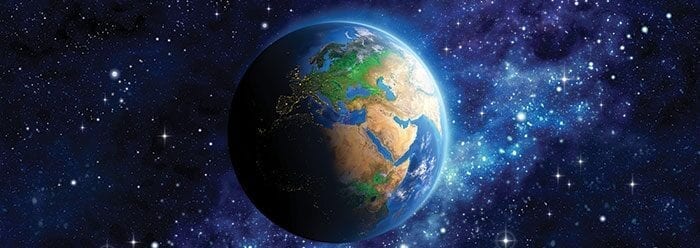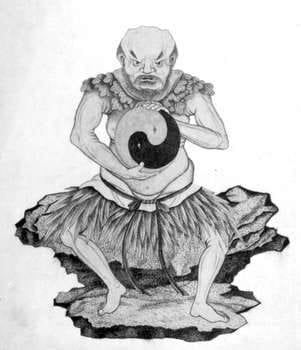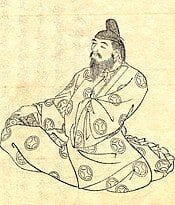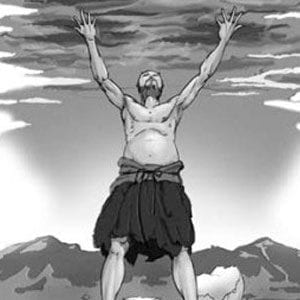Introduction
 Our universe is highly ordered with galaxies, solar systems, planets and moons, all rotating with perfect symmetry and in harmony. In fact, the Greek word for universe is cosmos which means order. Life is incomprehensively complex and every member inter-dependent on other forms of life and its environment in a delicate balance that enables each to survive. Image credit: NASA.
Our universe is highly ordered with galaxies, solar systems, planets and moons, all rotating with perfect symmetry and in harmony. In fact, the Greek word for universe is cosmos which means order. Life is incomprehensively complex and every member inter-dependent on other forms of life and its environment in a delicate balance that enables each to survive. Image credit: NASA.
There are only two possibilities for the universe and life’s existence, these are:
They were created by a Supernatural Being
OR
They were created by nothing
The second is illogical and there is no third.[1]
Interestingly, a Supernatural Being has contacted us and told us that it was He who created everything. Also, He told us how, He simply spoke everything into existence and in what order He did it; we can read about it in the Bible; Genesis chapter 1. The reason He did it; was because it pleased Him.[2]
Biblical Creation Critics
The biblical account of creation is often criticised, with many people, including liberal Christians, insisting that it is not meant to be taken literally, but must be allegorized and/or that it is all poetry in order to give an explanation to people lacking modern understanding.
One such critic is Professor in Religion, Shawna Dolansky[3] who claims that the biblical account of creation is only one of many myths which were invented to satisfy the needs of primitive people:[4]
Like other ancient peoples, the Israelites told multiple creation stories. The Bible gives us three (and who knows how many others were not preserved?). Genesis 1 differs from Genesis2-3, and both diverge from a third version alluded to elsewhere in the Bible, a myth of the primordial battle between God and the forces of chaos known as Leviathan.
These are bland statements without any supporting evidence offered. They, Dolsnsky and fellow travelers, many of them in Bible colleges, obviously come from a position of belief that the Bible is not God inspired and is no different from other ancient religions documents.
Other religious explanations of creation
Before addressing biblical creation, a brief examination of how other religions explain our existence is presented so that their account of creation can be compared with that of the Bible.
The Hindu texts known as the Upanishads describe the creation of the world as the breaking of a cosmic egg.
The Aztecs of Mexico believed that the present world was the fifth that the gods had created. It was fated to end in universal destruction by earthquakes. The four previous worlds had been destroyed by a great flood, the falling of the sky, a firestorm, and a windstorm.
The Maya believed that the gods made three unsuccessful attempts to create human beings before achieving a satisfactory result. Their first creations–animals, people made of mud, and wooden people–disappointed them in various ways, and they abandoned or destroyed them. Finally, the gods made people of maize (corn) who were perfect, so perfect that their creators clouded their vision to prevent them from seeing too far.
A Japanese tradition, preserved in a volume of mythological history called the Kojiki, says that before creation, there was an oily sea. Gods came into being in the High Plains of Heaven. After seven generations of deities, there came the first human ancestors, whose task was to make solid land. They stirred the sea with a jeweled spear. Drops that fell from the spear formed the islands of Japan.
A Chinese creation story tells how Pan Gu was hatched from a cosmic egg. One part of the eggshell formed the heavens; the other part became the earth. For 18,000 years, Pan Gu stood between them, keeping them apart by growing ever taller. Finally, he became weary, lay down, and died. From his eyes came the sun and moon, from his hair the stars, from his breath the wind, and from his body the earth.
A Norse creation story tells how the giant Ymir took shape in the huge icy emptiness called Ginnungagap. Ymir’s great cow licked the ice, creating the first gods, including Odin. The gods killed Ymir and divided his body into a series of worlds on three levels: Asgard, the realm of gods; Midgard, the realm of people, giants, dwarfs, and elves; and Niflheim, the realm of the dead. The gods created the first man and woman from an ash and an elm tree.
According to Polynesian tradition, a creator god named Tangaloa sent a bird messenger over an endless primal sea. At last Tangaloa threw a rock into the sea so the tired bird would have a place to land. Then the god created all the islands in the same way. The bird made the first people by giving arms, legs, hearts and souls to maggots.
It is easy to see that these creation stories were devised by man. Now let’s compare them with the biblical account of creation.
Biblical Creation
The biblical account of creation appears in the first chapter of the book of Genesis. The narrative is detailed and the act of creation is attributed to God in its entirety. It was accomplished in six days. It was orderly and highly structured, with each day having its own start and finish. That is: morning and evening. Each day was completed before the next act of creation was started. It is a logical sequence of events with the pinnacle of creation being man—the only being created in the image of God.
A straight forward reading shows that God created everything in six, 24-hour days. Professor James Barr, Regius Professor of Hebrew at the University of Oxford, has written:
Probably, so far as I know, there is no professor at any world-class university who does not believe that the writer(s) of Genesis 1-11 intended to convey to their readers the idea that creation took place in six days which were the same as the days of 24 hours we now experience.[5]
The Gap Theory
Some critics propose that there is a re-creation commencing in Genesis 1:2 after God had initially created the heavens and earth in verse 1. This has become known as the Gap Theory but verse one is a summary statement and the Hebrew syntax does not naturally lend itself to such a translation.[6]
Creation ended on day six
Genesis 2:2 states:
By the seventh day God finished the work he had been doing; so on the seventh day he rested from his work. And God blessed the seventh day and made it holy, because on it he rested from all the work of creating that he had done.
This statement is in accordance with the first law of thermodynamics which holds that matter/energy[7] cannot be created or destroyed. After six days all creation ceased. The only exception to this is when God intervened with special acts of creation like Jesus feeding the 5,000 from two fish and five loaves.[8]
The reason God took six days for His creation was to set an example for mankind as shown in the fourth commandment of Exodus 20:9: Six days you shall bear labor and do all your work, but the seventh day is a sabbath (rest) to the Lord your God. On it you shall not do any work,…
Clearly, Genesis 1-2:3 is an overview of God’s creation and 2:3 tells us that God had finished his work of creation. This is followed by detailed creation of humanity after introductory verses 4-6. This is not another account of creation to compete with chapter one, but rather a zooming in on the creation of mankind and to highlight God’s personal involvement in it; verse 7 states:
the LORD God formed the man from the dust of the ground and breathed into his nostrils the breath of life and the man became a living being.
And then God’s involvement in the formation of Eve; 2:21-22 states:
So the LORD God caused the man to fall into a deep sleep and while he was sleeping, he took one of the man’s ribs and closed up the place with flesh. Then the LORD God made a woman from the rib he had taken out of the man.[9]
The reason for the special attention to God’s creation of humanity is because the man and woman are different from the creation of everything else, because mankind was created in the image and likeness of God. Genesis 1:27 states:
So God created man in his own image, in the image of God he created him; male and female he created them.
The structure of Genesis
Tôledôt[10] structure
The entire book of Genesis is structered with the phrase: “These are the tôledôt of x.” So, the phrase functions as a heading for what follows. The tôledôt can introduce either a narrative or a genealogy or a combination. The most common being: These are the generations of …. Some examples are the tôledôt; This is the account of the heavens and earth when they were created (Genesis 2:4) and covers the narrative to 4:26. The next tôledôt is 5:1 which is: This is the written account of Adam’s line which proceeds to 6:8. The next tôledôt is 6:9; This is the account of Noah. Other uses of the tôledôt occur at 10:1, 11:10, 11:27, 25:12, 25:19,36:1, 36:9 and 37:2. Genesis consists of eleven family documents headed by a tôledôt.
Richard Middleton is Professor of Biblical Worldview and Exegesis at Northeastern Seminary (Rochester, NY) and he makes the point concerning Genesis 1; Given the structure of the book of Genesis, it makes sense to think of Gen 1:1–2:3 (which comes before the first tôledôt heading) as the Prologue to the entire book of Genesis, setting up the initial conditions for creation (Gen 1:1–31), after which God “rests” from creating (Gen 2:1–3), having entrusted the earthly realm to humanity, whom he made in his image, and granted dominion as his stewards (Gen 1:26–28). What follows in the book of Genesis is a compressed account of human history, which developed out of the heavens and the earth.[11]
Chiasmus structure
Another structural feature of Genesis is chiasmus, where the same language and style elements are repeated in the second part of the verse in reverse order with the last matching the first and the first matching the last.
In his 800-page treatise on Genesis chapters 1 to 11, Dr Jonathan Sarfati, explains the topic and gives many examples of chiasmus.[12] Two of them are reproduced below, a shorter one of Genesis 9:6
A Whoever sheds
B the blood
C of man
C’ by man shall
B’ his blood
A’ be shed
and a larger, spectacular and fascinating example, is the chiastic structure of the Genesis flood (Genesis 6:1 to 9:19):
A Noah: the righteous man (6:9)
B Noah’s sons: Shem, Ham and Japheth (6:10)
C Earth filled with violence and corruption (6:11-12)
D First divine address (1): earth to be destroyed (6:13)
E First divine address (2): Noah to build Ark (6:14-22)
F Second divine address (1): command to enter Ark (7:1-3)
G Second divine address (2): 7-day wait for Flood (7:4-5)
H 7 days waiting for flood (repeated) (7:6-10)
I Beginning of Flood and entry into Ark (7:11-15)
J God shuts the door (7:16b)
K 40 days flood, waters increase (7:17a-18)
L Waters prevail, mountains covered (7:19-20)
M 150 days waters prevails (7:21-24)
N GOD REMEMBERS NOAH (8:1a)
M´ 150 days waters abate (8:1b-5)
L´ Waters abate, mountain tops visible (8:5)
K´ 40 days (end of) (8:6a)
J´ Noah opens window of ark (8:6b)
I´ Raven and dove leave ark (8:7-9)
H´ 7 days waiting for waters to subside (8:10-11)
G´ 7 days waiting for waters to subside (8:12-14)
F´ Third divine address: command to leave Ark (8:15-19)
E´ Noah builds an altar (8:20)
D´ God’s commitment to preserve the earth (8:21-22)
C´ Fourth divine address: covenant blessing and peace (9:1-17)
B´ Noah’s sons: Shem, Ham and Japheth (9:18-27)
A´ Noah: life and death (9:28-29)
The book of Genesis is replete with chiasmus. Numerous chiastic structures for the whole book, commencing with the first chapter can be found here: https://chiasmus.dns-systems.net/wp-content/uploads/2015/10/genesis-flood-chiasm-sds.pdf.
The creation narrative is one indivisible account
Sarfati makes the comment:
The editor [of Genesis] was more than just a copyist of documents. Rather, there are large scale artificial literary structures, evidence of a unifying hand who painstakingly edited the sources into a whole. Victor Hamilton, who was professor of Bible and Theology at Asbury University for 39 years states:
The rhetorical features of Genesis are so distinctly woven into one tapestry as to constitute an unassailable case for the unity of the section, and most likely composition by a single hand.[13]
Further, Sarfati shows that Genesis like the rest of scripture, was written to be understood, which is, the perspicuity of scripture. All of this stands against the day-age and gap theories which really are only an attempt to accommodate evolution and has nothing to do with the way the text was written. This is totally unnecessary, because evolution never happened and it is not supported by operational science. For more on the impossibility of evolution, click here
In his book, Sarfati demolishes arguments that are used to reduce Genesis to that of a mere collection of ancient documents such as the Documentary Hypothesis with its J, E, D and P authors.[14]
Summary
The most important book in scripture is the Book of Genesis because it is foundational to the whole of the Bible, as it explains how everything came about, disclosures the close and warm relationship God had with the pinnacle of His creation; mankind. It shows that we all are sinners and yet highlights the evil in some people (Cain) and the God-given love in others (Joseph) and all else in between in this fallen world. It provides an explanation of why people wear clothes and why we marry. But most importantly, it reveals God’s hatred of our sinful state and why through His exceeding great love, He sent His Son, the Second Person of the Trinity, the Lord Jesus Christ, to pay the penalty for our sin and in doing so, restored for all who believe, the intimate association the first humans had with their creator that existed in the Garden of Eden before the fall.
[1] The idea that the universe has always existed is not tenable because its amount of usable energy is decreasing in accordance with the Second Law of Thermodynamics and it will eventually end with no motion within it and a uniform temperature throughout it. It was created wound up and it is now winding down.
[2] Colossians 1:16; Revelation 4:11.
[3] Adjunct Research Professor and Instructor in the program in Religion at the College of Humanities, Carleton University in Ottawa, Ontario.
[4] Biblical Archaeology Review, January/February, 2016, page 18.
[5] Russell Grigg, Creation, 16(1), 1993, pages 38-41. His reference 2.
[6] Zondervan Illustrated Bible Dictionary, Zondervan, 2011, page 316-17.
[7] Schrodinger’s famous E=mc2 equation showed that matter and energy are interchangeable.
[8] Matthew 14:13-21.
[9] The rib bone is the only bone in the human body that will re-grow if it has been removed providing that the sheath that covers the rib is left intact.
[10] Tôledôt (also seen as tôledôt) is a Hebrew word most often translated “generations.” Tôledôt is the story or genetic line that came from—generated from—a person or event.
[12] Jonathan Sarfati, The Genesis Account, Creation Book Publishers, 2015, pages 12-15.
[13] Ibid page 12.
[14] Ibid pages 22-26.

